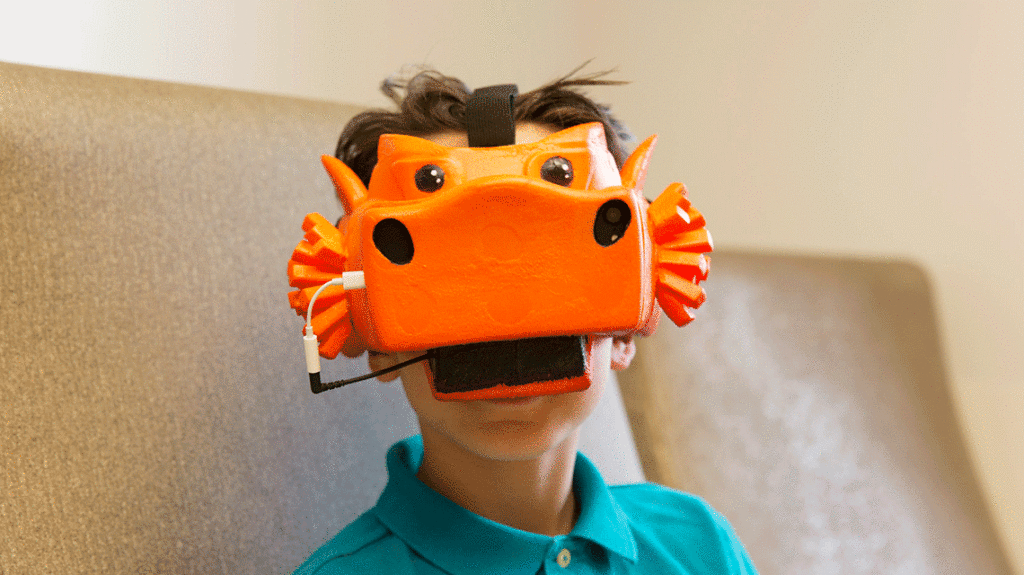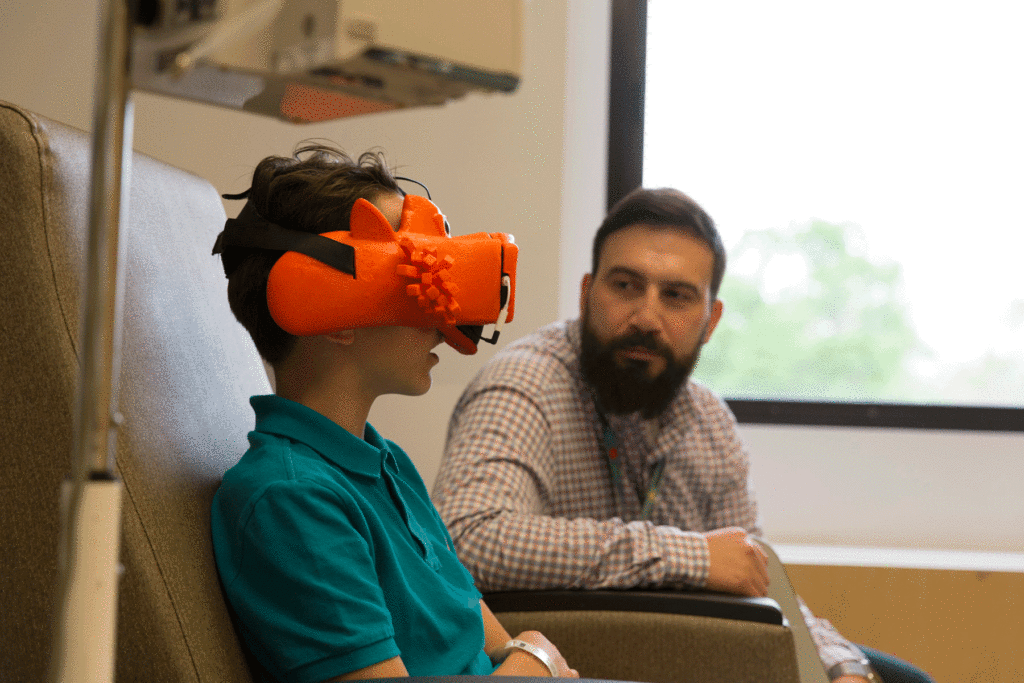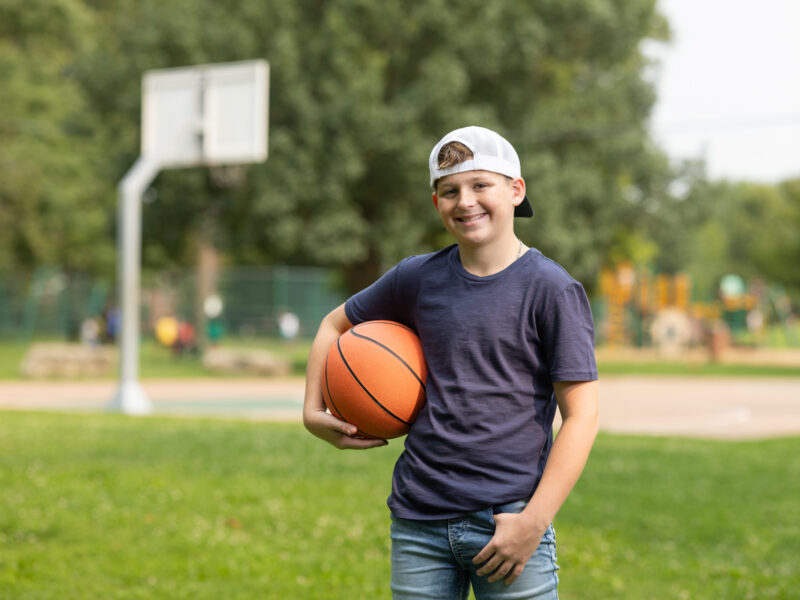Creative Reality: Using a New Platform Technology to Improve Patient Experience
Creative Reality: Using a New Platform Technology to Improve Patient Experience https://pediatricsnationwide.org/wp-content/uploads/2017/09/dragon-headset-header-1024x575.gif 1024 575 Abbie Miller Abbie Miller https://pediatricsnationwide.org/wp-content/uploads/2023/05/051023BT016-Abbie-Crop.jpg- September 12, 2017
- Abbie Miller

Amy Dunn, MD, had a problem. Some of her patients in the hematology clinic at Nationwide Children’s Hospital receive hundreds of needle sticks each year.
“Needle phobia is very real for these patients and their families,” says Dr. Dunn, director of Pediatric Hematology at Nationwide Children’s. “In some cases, ports need to be implanted so that these children can get the medicine they need. In every case, appointments and infusions are filled with stress, anxiety and discomfort for everyone involved.”
When Dr. Dunn approached the User Experience team – which works with researchers to create people-friendly health technology solutions – about this problem, the team started on a journey of “what could be.”
AN UNCONVENTIONAL TEAM FOR AN UNCONVENTIONAL SOLUTION
An artist, designer, gamemaker and doctor work at a hospital… It may sound like the beginning of a really confusing joke, but in this case, it’s the beginning of a story about innovation. About a team that is working to create a new reality of how technology, clinical research and patient care can intersect.
The solution Dr. Dunn and the User Experience team created is a suite of virtual reality games, named Voxel Bay, built entirely in-house with evidence-based research as the cornerstone. Additionally, they solved the problem of getting a child-sized, affordable, clinically appropriate virtual reality headset by building their own.
So what makes Voxel Bay and its creators unique? Certainly, virtual reality has been explored in medicine previously. One of the most successful uses of virtual reality in the medical setting is for burn victims during dressing changes. Studies have shown that virtual reality experiences during dressing changes result in a decrease in required pain medication and psychological distress. But most of that work has been done in adults.
“Every component of Voxel Bay and the headset was designed with the needs and goals of the pediatric patient with hemophilia in mind,” says Jeremy Patterson, lead for User Experience Technology Research and Development at Nationwide Children’s. “The true magic of Voxel Bay is in the entire experience that was crafted around a specific problem–a targeted experience that was designed and created in tandem with clinical expertise and research.”
“We now have an in-clinic experience that begins when the patient is handed the headset and then transitions into the meat of the experience, which is the games and activities,” he elaborates. “This is exactly the tactic employed by Disney World for their iconic experience. We have brought a rich experience like this into a pediatric clinic; and this is a big deal. This is what resonates with people, and most importantly with our patients and families.”
This bench-to-bedside effort exemplifies the results that can be obtained when the clinical staff and the design team work closely together.
“We wanted to do more than make something fun and cute,” says Dr. Dunn, who is also a professor of Pediatrics at The Ohio State University College of Medicine. “The aspect of clinical utility is paramount, and we were able to conduct a clinical trial with the system to measure the impact it had on our patients. We were able to show that we could incorporate our virtual reality platform into a busy hemophilia clinic without lengthening time in clinic. Additionally, the medical team, parents and children really saw what a difference Voxel Bay made in the patient experience.”

Jeremy Patterson with patient Jackson, who was part of the clinical trial. Jackson is wearing the latest version of the headset.
According to Charmaine Biega, RN, nurse clinician and leader of the clinical trial, the feedback from clinic staff, patients and parents has all been positive.
“The time difference for blood draws and factor infusions after adding Voxel Bay to the clinic visit was less than one minute,” she says. “But the difference in patient experience was dramatic. It was a 180-degree change for some of our most challenging patients.”
Voxel Bay was presented at Association of Computing Machinery (ACM) SIGGRAPH 2016 – an international conference and exhibition on computer graphics and innovation techniques.
Since then, the program has caught the attention of others. Voxel Bay has been the recipient of several honors and awards, including being a nominated finalist at South by Southwest (SXSW) Interactive for 2017, receiving the #WhatsGood award at SXSW, being named the Children’s Miracle Network Achievement of the Year and being a 2017 Most Wired Children’s Hospitals Innovation Finalist.
MANAGING RISK
The lessons for innovation gleaned from the creation and development of Voxel Bay resonate with innovators everywhere: Take calculated risks, think big, use your resources, start, fail forward and keep going. Let your passion fuel you.
“In my mind, our biggest risk was the risk of failure,” says Dr. Dunn. “Many times along the way we ran into obstacles that could have derailed the project. But we have a team of people who are really passionate about making a difference in the lives of our patients, and we were determined not to give up.”
But it’s not just hammering away at the problem until something gives. “There’s a methodology to our brand of innovation,” explains Patterson. “The key is taking informed and calculated risks. You can fail, but you need to set yourself up for graceful failure. This comes through informed, strategic bets on how to move forward in such a way that if you fall down, you are at least falling in the right direction.”
By introducing this concept and way of working to the institution, the User Experience team has contributed to the innovation culture in a way that sets the stage for continued innovations beyond Voxel Bay.
“This level of innovation at a pediatric institution is unique, but it shouldn’t be. This collaboration across divisions, departments and specialties should be the norm,” says Robert Strouse, MFA, User Experience Designer, Research Information Solutions & Innovation at Nationwide Children’s. “Why can’t this happen everywhere? My thought is that it can. And it should.”
One example of the method described by Patterson is the iterative design process that led to the creation of the clinic-friendly virtual reality headset.
“When we started this project, we started with a commodity headset, an Oculus Rift dev kit to be exact. But when doing an initial test of the games with some children at a hemophilia fundraising event, we realized that the headset was a major pain point for us when setting things up and for the kids playing,” says Patterson. “We saw that the games were fun, the breath controls were working, but the headset needed help. That’s when we knew we needed to design our own headset.”
By continually learning from their collective experiences, the team continued to find a way forward.
“Version 14 of the headset finally made it into the clinic,” says Strouse, lead designer of the headset. “We’re now on version 18, which is a headset that looks like the dragon in the game and is made entirely out of the same material as a stress ball. Despite our forward progress, we continue to learn from our patients and evolve the headset – as well as the entire system – to meet the needs of patients, parents and practitioners.”
Part of managing risk and utilizing resources includes managing the financial picture. Innovative projects like this one cost money, and funding is certainly a concern for researchers, clinicians and institutions alike.
“We have had a series of grants to help along the way, starting with an internal technology development grant, a Clinical and Translational Science Voucher from The Ohio State University and Nationwide Children’s, a grant from the National Hemophilia Foundation and, most recently, a grant from the Department of Education – ICORP@Ohio,” says Dr. Dunn.
Beyond the financial support of grants, Dr. Dunn also credits the institution for having the infrastructure to accommodate innovative projects like this.
“The hospital was instrumental in setting up and funding User Experience from the beginning; I think this was incredibly forward thinking and unique among children’s hospitals,” she says.
WHAT’S NEXT?
“A lot of people we’ve talked with are excited about what could be next,” says Dr. Dunn. “If you think about how we can take what we’ve done, what we’ve learned, and expand it to other parts of the hospital or other parts of the patient experience, it’s a really exciting prospect.”
An exciting prospect that takes time, effort and funding to do it right. According to Dr. Dunn, the Voxel Bay team is actively pursuing partnerships and clinical research funding to explore the use of the platform to help patients in a variety of clinical situations.
And for other clinicians, researchers and innovators who want to blaze their own trails, Dr. Dunn and her team are enthusiastic supporters.
“I think we should always strive to find new and better ways to help our patients,” says Dr. Dunn. “My best advice is to really think about the challenges faced in the care of patients and then work collaboratively to come up with new ways to overcome those challenges.”
Strouse agrees. “Identify what gets in your way the most. Don’t edit it, don’t try to solve it, just identify it and name it. Then, look for the people who can help. Maybe they’re in another department, another building or another institution. Reach out. This is the beginning of the path from health care provider to health care innovator.”
Photo credit: Nationwide Children’s
About the author
Abbie (Roth) Miller, MWC, is a passionate communicator of science. As the manager, medical and science content, at Nationwide Children’s Hospital, she shares stories about innovative research and discovery with audiences ranging from parents to preeminent researchers and leaders. Before coming to Nationwide Children’s, Abbie used her communication skills to engage audiences with a wide variety of science topics. She is a Medical Writer Certified®, credentialed by the American Medical Writers Association.
- Abbie Millerhttps://pediatricsnationwide.org/author/abbie-miller/
- Abbie Millerhttps://pediatricsnationwide.org/author/abbie-miller/
- Abbie Millerhttps://pediatricsnationwide.org/author/abbie-miller/
- Abbie Millerhttps://pediatricsnationwide.org/author/abbie-miller/
- Posted In:
- Features







